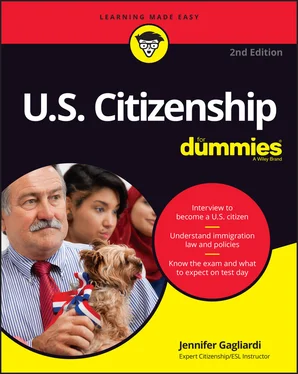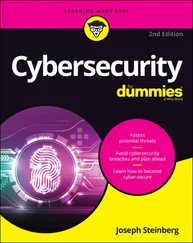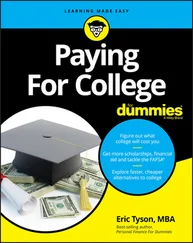Jennifer Gagliardi - U.S. Citizenship For Dummies
Здесь есть возможность читать онлайн «Jennifer Gagliardi - U.S. Citizenship For Dummies» — ознакомительный отрывок электронной книги совершенно бесплатно, а после прочтения отрывка купить полную версию. В некоторых случаях можно слушать аудио, скачать через торрент в формате fb2 и присутствует краткое содержание. Жанр: unrecognised, на английском языке. Описание произведения, (предисловие) а так же отзывы посетителей доступны на портале библиотеки ЛибКат.
- Название:U.S. Citizenship For Dummies
- Автор:
- Жанр:
- Год:неизвестен
- ISBN:нет данных
- Рейтинг книги:3 / 5. Голосов: 1
-
Избранное:Добавить в избранное
- Отзывы:
-
Ваша оценка:
- 60
- 1
- 2
- 3
- 4
- 5
U.S. Citizenship For Dummies: краткое содержание, описание и аннотация
Предлагаем к чтению аннотацию, описание, краткое содержание или предисловие (зависит от того, что написал сам автор книги «U.S. Citizenship For Dummies»). Если вы не нашли необходимую информацию о книге — напишите в комментариях, мы постараемся отыскать её.
U.S. Citizenship For Dummies
U.S. Citizenship For Dummies
U.S. Citizenship For Dummies — читать онлайн ознакомительный отрывок
Ниже представлен текст книги, разбитый по страницам. Система сохранения места последней прочитанной страницы, позволяет с удобством читать онлайн бесплатно книгу «U.S. Citizenship For Dummies», без необходимости каждый раз заново искать на чём Вы остановились. Поставьте закладку, и сможете в любой момент перейти на страницу, на которой закончили чтение.
Интервал:
Закладка:
 If you are inside the United States and are waiting for an immigrant visa number to adjust your status, you must maintain valid nonimmigrant status while in the United States, or you risk encountering a three- or ten-year bar to naturalization.
If you are inside the United States and are waiting for an immigrant visa number to adjust your status, you must maintain valid nonimmigrant status while in the United States, or you risk encountering a three- or ten-year bar to naturalization.
Gaining Permanent Resident Status (or a Green Card)
As we discuss in Chapter 1, most people gain lawful permanent residence through a family connection or through employment. In the following sections, we explore these categories in more detail, as well as other ways people can legally live and work in the United States on a permanent basis.
Understanding the family preference categories
Family-based immigrant visa numbers are distributed according to preference categories. The higher you rank on the preference scale, the sooner you’re likely to receive a number. The following are the four family-preference categories:
First preference (F1): Unmarried sons and daughters (21 years of age and older) of U.S. citizens
Second preference (F2A): Spouses and children (unmarried and under 21 years of age) of lawful permanent residents
Second preference (F2B): Unmarried sons and daughters (21 years of age and older) of lawful permanent residents
Third preference (F3): Married sons and daughters of U.S. citizens
Fourth preference (F4): Brothers and sisters of U.S. citizens (if the U.S. citizen is 21 years of age or older)
See USCIS Green Card for Family Preference Immigrants at www.uscis.gov/green-card/green-card-eligibility/green-card-for-family-preference-immigrants .
 After the visa petition filed for them by their sponsoring relative is approved by the USCIS, the immediate relatives of U.S. citizens — parents, spouses, and unmarried children under the age of 21 — usually don’t have to wait for an immigrant visa number to become available.
After the visa petition filed for them by their sponsoring relative is approved by the USCIS, the immediate relatives of U.S. citizens — parents, spouses, and unmarried children under the age of 21 — usually don’t have to wait for an immigrant visa number to become available.
Marrying your way to permanent residence
Although it’s usually relatively easy for the foreign-born spouses of U.S. citizens or lawful permanent residents to come to the United States, the USCIS doesn’t take kindly to folks who marry for the sole purpose of obtaining a green card. The countless TV sitcom and movie plots we’ve all seen on this subject are close to the truth. The USCIS wants to see evidence that yours is truly a marriage and not just a union on paper. You and your spouse should expect to answer questions about each other and about the marriage as well as provide physical evidence of the relationship. For this reason, in addition to important documents like your marriage certificate, be sure to save things like travel documents, vacation and family photos, billing statements, and other tangible evidence of your life together.
Marrying a U.S. citizen
If your spouse is a U.S. citizen, either born or naturalized, you are considered an immediate relative and are likewise usually eligible for an immigrant visa immediately, providing your I-130 Petition for Alien Relative (the form your sponsoring relative filed on your behalf) has been approved by the USCIS.
If you’ve been married less than two years when you gain lawful permanent resident status, that status is given on a conditional basis — conditional on your still being married after a full two years. At that time, you and your spouse will need to apply together to remove the condition.
 You must apply to remove conditional status within 90 days before the two-year anniversary of the date your conditional permanent resident status was granted. If you fail to file during this time, you’ll be considered out of status as of the two-year anniversary, and you may be subject to removal from the country. Use USCIS Form I-751 to apply to remove the condition. For more information, see the following:
You must apply to remove conditional status within 90 days before the two-year anniversary of the date your conditional permanent resident status was granted. If you fail to file during this time, you’ll be considered out of status as of the two-year anniversary, and you may be subject to removal from the country. Use USCIS Form I-751 to apply to remove the condition. For more information, see the following:
USCIS I am Married to a U.S. Citizen: www.uscis.gov/citizenship/learn-about-citizenship/citizenship-and-naturalization/i-am-married-to-a-us-citizen
Remove Conditions on My Status Based on Marriage: www.uscis.gov/forms/explore-my-options/remove-conditions-on-my-status-based-on-marriage
I-751, Petition to Remove Conditions on Residence: www.uscis.gov/I-751
Marrying a green-card holder
If you marry a lawful permanent resident of the United States, you aren’t considered an immediate relative. Instead, you fall under the family second preference category. If your spouse’s I-130 Petition for Alien Relative form is approved, the Department of State will notify you when a visa number becomes available.
 If you were married before your husband or wife became a permanent resident, you cannot obtain permanent resident status along with your spouse without being subject to visa limits. If, for whatever reason, you did not physically accompany your spouse to the United States when they became a permanent resident, you may be eligible to receive following-to-join benefits. This means your husband or wife won’t have to file a separate I-130 Petition for Alien Relative form, and you won’t have to wait any extra time for an immigrant visa to become available. You may be eligible for following-to-join benefits, provided your marriage still exists and your husband or wife received their lawful permanent residence status in one of the following ways:
If you were married before your husband or wife became a permanent resident, you cannot obtain permanent resident status along with your spouse without being subject to visa limits. If, for whatever reason, you did not physically accompany your spouse to the United States when they became a permanent resident, you may be eligible to receive following-to-join benefits. This means your husband or wife won’t have to file a separate I-130 Petition for Alien Relative form, and you won’t have to wait any extra time for an immigrant visa to become available. You may be eligible for following-to-join benefits, provided your marriage still exists and your husband or wife received their lawful permanent residence status in one of the following ways:
Through a diversity immigrant visa (winning the visa lottery)
Through an employment-based immigrant visa
Based on a relationship to a U.S. citizen brother or sister
Based on a relationship to U.S. citizen parents after you were already married
If you’re a lawful permanent resident of the United States who marries a noncitizen spouse inside of the U.S., you can file Form I-130, Petition for Alien Relative. After a visa number becomes available, apply to adjust your spouse’s status to permanent residency using Form I-485.
Legally marrying a green-card holder OUTSIDE of the U.S.
Although no exact document exists in the United States, all civil-law countries require proof of legal capacity to enter into a marriage contract. This means that the lawful permanent resident of the United States must obtain certification by competent authority that no impediments to the marriage exist. Unless the foreign authorities will allow such a statement to be executed before one of their consular officials in the United States, the parties of a prospective marriage abroad must execute an affidavit at the U.S. embassy or consulate in the country where the marriage will occur. This affidavit of eligibility to marry states that both parties are free to marry. Some countries require witnesses to these affidavits. Check the law where you plan to marry.
A lawful permanent resident of the United States who married an noncitizen spouse outside of the U.S. can bring the noncitizen spouse to the United States by filing Form I-130, Petition for Alien Relative. When Form I-130 is approved and a visa is available, it will be sent for consular processing and the consulate or embassy will provide notification and processing information.
Marrying a U.S. Service member
Интервал:
Закладка:
Похожие книги на «U.S. Citizenship For Dummies»
Представляем Вашему вниманию похожие книги на «U.S. Citizenship For Dummies» списком для выбора. Мы отобрали схожую по названию и смыслу литературу в надежде предоставить читателям больше вариантов отыскать новые, интересные, ещё непрочитанные произведения.
Обсуждение, отзывы о книге «U.S. Citizenship For Dummies» и просто собственные мнения читателей. Оставьте ваши комментарии, напишите, что Вы думаете о произведении, его смысле или главных героях. Укажите что конкретно понравилось, а что нет, и почему Вы так считаете.












